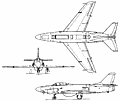|
| First flown as a prototype on 3 November 1952, the Saab-32 has given the Flygvapen some 28 years of faithful service since deliveries began in 1955, emphasising the capability of this excellent aircraft. Design of this aircraft was initiated in the late 1940s to provide the Swedish air force with an all-weather attack aircraft powered by two de Havilland turbojets, but the promise of an indigenous, and consequently cheaper engine brought cancellation of the original project. Design was drawn up around the new Swedish powerplant, but development delay of this engine threatened Saab's programme and, instead, it was to be given a go-ahead following a decision to power the aircraft by a Rolls-Royce Avon turbojet. Four prototypes of the Saab-32 design were ordered, the type being a two-seat cantilever low-wing monoplane with powered controls, retractable tricycle landing-gear, and the crew of two accommodated in tandem on ejection seats in a pressurised cockpit. Its wing incorporated 35° of sweepback and like that of the Saab-29 before it was evaluated in scaled-down form on a Saab Safir trainer.
Production was started in 1953 of the A 32A Lansen (lance), an all-weather attack aircraft powered by a Swedish-built version of the Rolls-Royce Avon Series 100, developing 4500kg afterburning thrust. When production of the A 32A ended in mid-1958, deliveries began almost immediately afterwards of the J 32B all-weather/night fighter, of which the first example had flown on 7 January 1957. It introduced the Flygmotor RM6B turbojet, a licence-built version of the Rolls-Royce Avon Series 200 which developed 6900kg afterburning thrust, providing much enhanced performance. Production of the J 32B ended in early 1960. Built almost in parallel with this version was the S 32C reconnaissance aircraft with a modified nose to carry advanced cameras as well as radar surveillance equipment. When production ended with delivery of the last J 32B, on 2 May 1960, a total of approximately 450 Saab-32s of all versions had been built for the Flygvapen. By 1993 only a handful of Lansens remained in military service, chiefly with the Forsokscentralen (test and trials unit) of the Flygvapen. Two-seat J 32B and J 32D target tugs are in use along with 14 specially modified J 32E electronic warfare 'aggressor' aircraft. These aircraft are operated by F13M, based at Malmslatt, with a permanent detachment at the RFN's Norland missile test range in Videsl, Lapland. Three J 32B target-tugs were formerly operated by civilian contractor Swedair, but they have now reverted to air force control.
 | A three-view drawing (900 x 761) |
| CREW | 2 |
| ENGINE | 2 x Rolls-Royce "Avon R.A.J.", 35.8kN |
| WEIGHTS |
| Take-off weight | 10000 kg | 22046 lb |
| Empty weight | 7000 kg | 15432 lb |
| DIMENSIONS |
| Wingspan | 13.0 m | 43 ft 8 in |
| Length | 14.7 m | 48 ft 3 in |
| Height | 4.8 m | 16 ft 9 in |
| Wing area | 37.4 m2 | 402.57 sq ft |
| PERFORMANCE |
| Max. speed | 1125 km/h | 699 mph |
| Ceiling | 15000 m | 49200 ft |
| ARMAMENT | 4 x 20mm cannons, bombs and missiles |
| lxbfYeaa, e-mail, 14.03.2024 05:35 20 reply | | Lars Hedman, e-mail, 11.03.2011 03:50 Swedish /English translations for worthy causes. Worked for SAAB early -50's,
pilot, with SE /ME /HE combat exp. etc. Located SoCal
PS... There is - was - a few years back a Lansen at Mohave. May still be there... reply | | Barry, 22.12.2010 16:32 Armament of the J32B consisted of 4 x 30mm Aden M /55 cannon and four Rb324 (Sidewinder) heat seeking missiles or FFAR pods. reply | | J.T.Kingsley, e-mail, 20.10.2009 20:20 I believe that the Lansens you talk about are two of the three I flew over in the nineties. reply | |
| | paul scott, e-mail, 17.08.2009 18:52 Another fine aircraft from the Saab stable - Bill, you're doing eveyone proud in keeping these, I do hope you can get one to fly, well done for trying in any case. reply | | Bill, e-mail, 23.06.2008 21:31 recently acquired 2 Saab Lansens. Seeking to return one to return one to flight status. Requiring assistance from any Swedish Flygvapnet veterans in So. Cal. area to assist with translation of tech manuals. Contact William E. Dietzel with American Airpower Museum. Thank you. reply |
|
Do you have any comments?
|
| 
COMPANY
PROFILE
All the World's Rotorcraft
|







